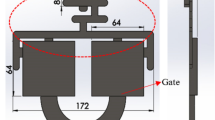Abstract
The use of vacuum to fill molds to form investment castings in a countergravity casting fashion was started in the early 1970s. This paper describes how the processes work and the reasons for their advantages in cost, quality, and process control. Countergravity casting is being done in sand, permanent, and investment (lost wax) ceramic molds and alloys are cast in air and inert atmospheres. The process started with common steels, was extended to heat resistant superalloys, and recently even titanium alloys are being cast routinely using ceramic crucibles. The use of a unique mold design enables a great reduction in metal cast to yield a given part, thereby greatly reducing the energy use in making such castings. Computerized control of the rate of vacuum application enables complete control of filling rates, permitting casting of very high quality castings in very viscuous metals, such as metal matrix composites of aluminum. These processes are used to produce more than $200 million worth of castings annually and this will greatly increase in the next few years due to the production of automotive exhaust manifolds in stainless steel.
Similar content being viewed by others
Author information
Authors and Affiliations
Additional information
Received: 21 July 1998 / Accepted: 10 September 1998
Rights and permissions
About this article
Cite this article
Chandley, G. Use of vacuum for counter-gravity casting of metals. Mat Res Innovat 3, 14–23 (1999). https://doi.org/10.1007/s100190050120
Issue Date:
DOI: https://doi.org/10.1007/s100190050120




